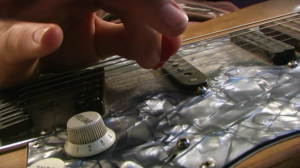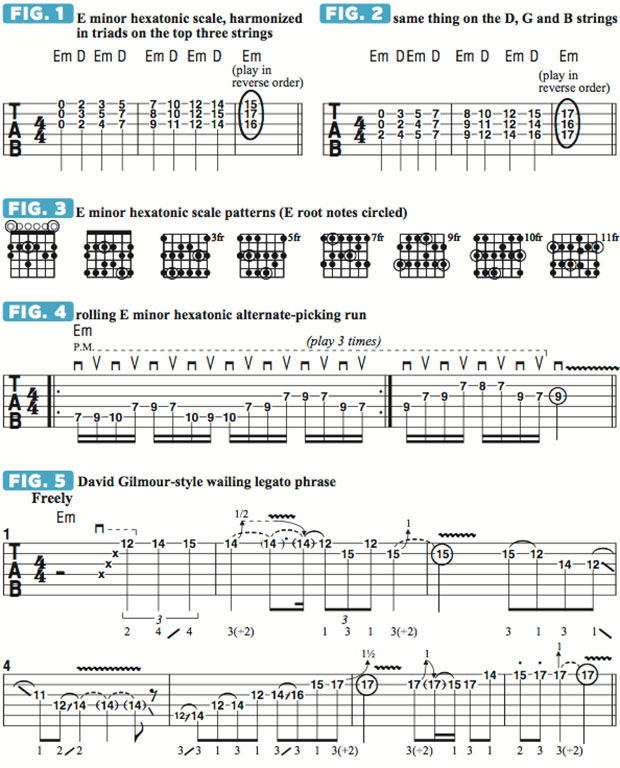
The Attractively Balanced and Highly Musical E Minor Hexatonic Scale
One of my favorite scales for rock lead playing and creating harmonized melodies is minor hexatonic.
As the name implies, it’s a six-note scale, and it is theoretically formed by adding the three notes of a minor triad to the three notes of a major triad rooted one whole step below.
For example, combining E minor (E G B) and D major (D F# A) gives you E minor hexatonic (E F# G A B D). The scale has a dark, serious quality that is intriguing and effective for creating a pensive musical mood.
This month, I’d like to show you some cool things you can do with the minor hexatonic scale, which we will then use as a reference point in subsequent columns for exploring other differently shaded but equally appealing hexatonics.
To start, let’s stick with the key of E minor, as it’s one of the most popular keys inrock. FIGURE 1 offers a useful way to get acquainted with the E minor hexatonic scale, with E minor and D major triad inversions on the top three strings “leapfrogging” each other up the neck. Play the inversions descending, as well as ascending, and feel free to pick the open low E string and allow it to ring while doing this.
To hear the scale as single notes, play only the high E string notes, or those on the B or G string only. Then, try pairing any two of the three strings to hear some sweetly sad two-part harmonies. As an additional resource, FIGURE 2 shows these two triads inverted up then neck on the D, G and B strings. Do the same things advised above for FIGURE 1.
You now have two convenient templates for creating two- or three-guitar harmony lead lines in the key of E minor! An alternative way to think of E minor hexatonic is E minor pentatonic (E G A B D) with the second, or ninth (F#), added.
FIGURE 3 illustrates a bunch of fingering patterns for E minor hexatonic across all six strings in a variety of positions, most of which are based on the standard E minor pentatonic “box” patterns, with F# notes added. As you run through these shapes, you will no doubt find that some are a little more finger- or pick-friendly and useful than others, or that just a portion of a particular pattern is useful across a select group of strings.
One nice thing about the minor hexatonic scale (or any other hexatonic scale, for that matter) is the fact that it is comprised of an even number of notes—six, as opposed to five or seven—which lends it a rhythmically balanced quality that makes it ideally suited for crafting phrases of even sextuplets or 16th notes, such as the rolling-16ths alternate picking run in FIGURE 4. Practice this run slowly at first, gradually building up speed, then try playing it in different places on the neck and using its string-crossing patterns as the basis for your own similarly structured licks across various string groups and in different keys, such as A minor or D minor.
Inspired by David Gilmour, FIGURE 5 is a wailing, legato lead phrase that includes half- and whole-step bends, hammer-ons, pull-offs and finger slides, as well as a fret-hand-muted string rake at the beginning and some reinforced bend vibratos. Notice how I emphasize the ninth, F#, with some of the bends, for an expressive effect.

Source: www.guitarworld.com












